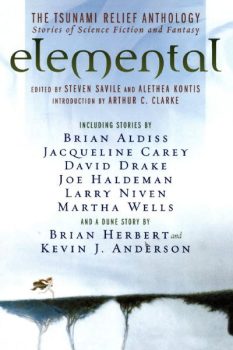A to Z Reviews: “Butterflies Like Jewels,” by Eric Nylund
 Eric Nylund’s “Butterflies Like Jewels” appeared in Elemental, an charity anthology published to support relief efforts for the 2004 Indian Ocean Tsunami that struck on Boxing Day. The anthology was co-edited by Alethea Kontis and Steven Savile and all the publisher’s and authors’ profits were donated to the Save the Children Tsunami Relief Fund.
Eric Nylund’s “Butterflies Like Jewels” appeared in Elemental, an charity anthology published to support relief efforts for the 2004 Indian Ocean Tsunami that struck on Boxing Day. The anthology was co-edited by Alethea Kontis and Steven Savile and all the publisher’s and authors’ profits were donated to the Save the Children Tsunami Relief Fund.
Nylund opened his story with a quote from Sir Eustace Carter Van Diem, the leader of a fictitious expedition to search for the Nile in 1841. While Van Diem and his companions were never heard from again, Nylund jumps to the modern era when one of Van Diem’s descendants, Edward Van Diem, is living in the Oceanview senior resident facility. Van Diem has garnered the attention of Dr. Lang because Van Diem is the last known person to talk to Dr. Ambrose before he went missing and Lang and Ambrose’s long and rocky relationship has led the police to believe that Lang may be responsible for Ambrose’s disappearance.

Following a short conversation with the centenarian Van Diem, Lang becomes convinced that despite the patient’s chart, he is suffering from some form of dementia. However, Lang is also convinced that Van Diem holds the secret to not being arrested by the police for Ambrose’s disappearance. When Van Diem asks Lang to retrieve a box of his possessions from the basement, Lang goes to find the thirty-year-old box.
The story raises questions about perception as Lang learns there is more to Van Diem than meets the eye. Lang must also come to terms with the idea that he might not be as different from his rival doctor as he thinks he is. His explorations of his rivalry and the search for Van Diem’s evidence takes him into a world which he isn’t entirely prepared to face, but Lang manages to make the necessary adjustments while learning more about Van Diem.
“Butterflies Like Jewels” is one of those fantasy stories, however, in which the fact that the story is fantasy and the author can create whatever rules to govern their world is a weakness rather than a strength. Because Nylund can set the terms of reality, it means the reader can never fully know whether Lang, Ambrose, and Van Diem are dealing with an objective reality, whether there is a sense of mass dementia, or if something else is happening.
At the same time, the introductory information about the Nile expedition of 1841 points toward the “reality” of what is happening (while simultaneously raising questions the story does not address). There is, of course, a tie between the two Van Diems that Nylund makes clear over the course of the story, but could have been built up a little more if the earlier Van Diem were shown to be better know.
 Steven H Silver is a twenty-time Hugo Award nominee and was the publisher of the Hugo-nominated fanzine Argentus as well as the editor and publisher of ISFiC Press for eight years. He has also edited books for DAW, NESFA Press, and ZNB. His most recent anthology is Alternate Peace and his novel After Hastings was published in 2020. Steven has chaired the first Midwest Construction, Windycon three times, and the SFWA Nebula Conference six times. He was programming chair for Chicon 2000 and Vice Chair of Chicon 7.
Steven H Silver is a twenty-time Hugo Award nominee and was the publisher of the Hugo-nominated fanzine Argentus as well as the editor and publisher of ISFiC Press for eight years. He has also edited books for DAW, NESFA Press, and ZNB. His most recent anthology is Alternate Peace and his novel After Hastings was published in 2020. Steven has chaired the first Midwest Construction, Windycon three times, and the SFWA Nebula Conference six times. He was programming chair for Chicon 2000 and Vice Chair of Chicon 7.
This sounds like an interesting one to read, since after reading Dugard’s Into Africa: The Epic Adventures of Stanley and Livingston, I’m left with the impression of the era of seeking the source of the Nile as being tonally similar to what you describe, here. It was a dreamful time of a sort of “mass dementia,” when people who weren’t certain of truths in their reality (the actual source of the Nile, where their heroes have gotten to, etc.) performed grand actions (the organization of immense rescue expeditions) and petty (defamation, the return of false reports of success) in pursuit of what they wanted to perceive reality to be, rather than what it was. Your description of Nylund’s story makes it sound like a micro-encapsulation of sorts, time-shifted to a more modern point.